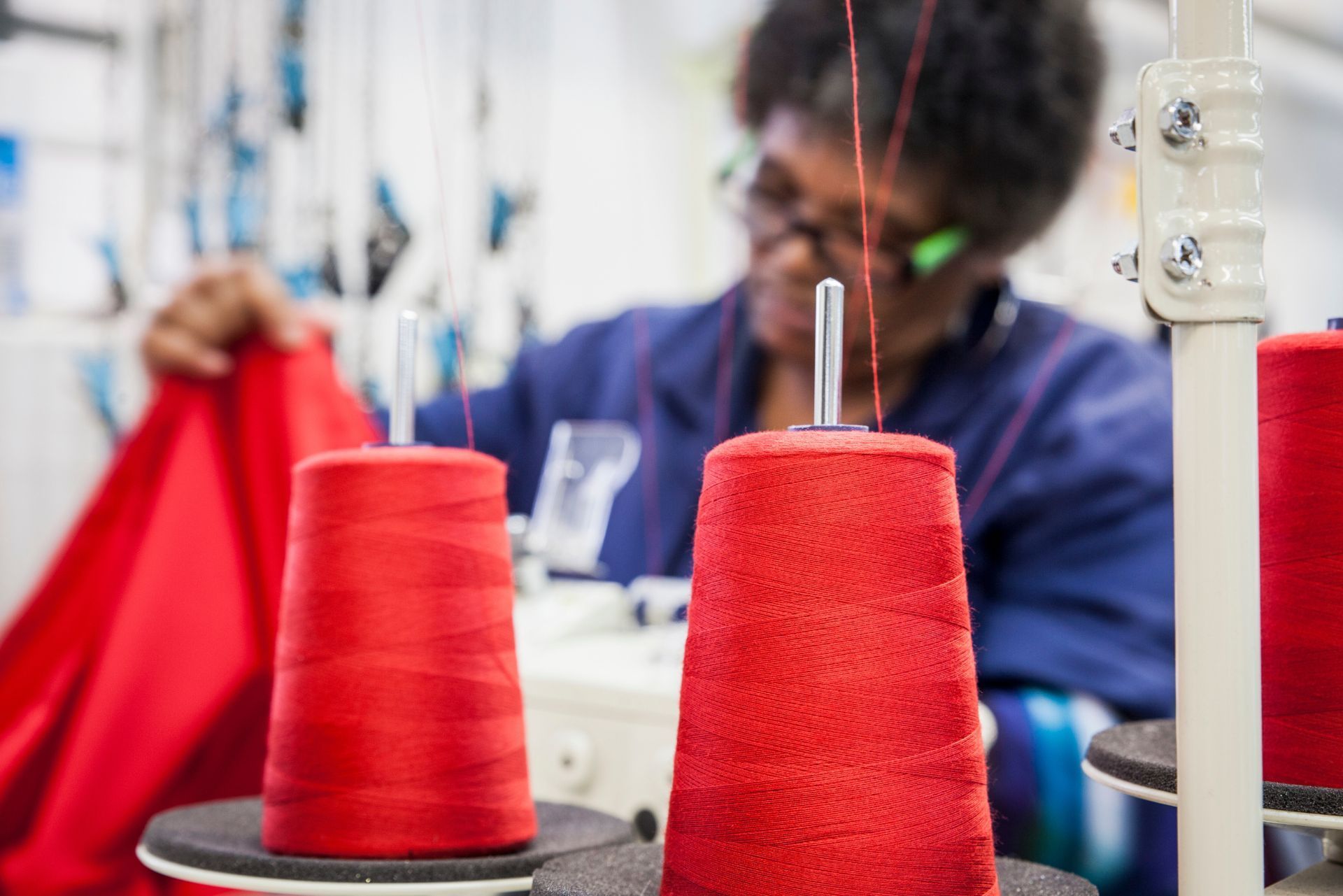Arizona Textile Manufacturer Insurance
See How We're Different:
or Call Us:(480) 526-3222

Most Common Business Policies
Index
Contact Us
In the vibrant world of textile manufacturing, businesses face unique challenges and risks. From the intricate processes involved in fabric production to the complex logistics of distribution, having the right insurance coverage is essential. Arizona's textile manufacturers must navigate a landscape filled with potential liabilities, making it crucial to understand the various insurance options available to protect their operations. This article delves into everything you need to know about textile manufacturer insurance in Arizona.
Understanding Textile Manufacturing Risks
Textile manufacturing involves a range of activities, from spinning and weaving to dyeing and finishing. Each of these processes carries inherent risks that can impact a business's operations and financial stability. Understanding these risks is the first step in determining the appropriate insurance coverage.
Common Risks in Textile Manufacturing
Textile manufacturers face various risks, including equipment breakdown, workplace accidents, and supply chain disruptions. Equipment failure can lead to costly downtime, while workplace injuries can result in significant liabilities. Additionally, fluctuations in raw material prices and changes in consumer demand can pose financial challenges.
Moreover, environmental risks, such as chemical spills or waste disposal issues, can lead to regulatory fines and damage to a company's reputation. Understanding these risks is vital for manufacturers to ensure they have adequate coverage. The complexity of textile production also introduces operational risks, such as quality control failures, which can result in defective products and subsequent recalls. These issues not only affect profitability but can also tarnish a brand's image, making it crucial for manufacturers to implement robust quality assurance protocols throughout the production process.
The Importance of Insurance in Mitigating Risks
Insurance serves as a safety net for textile manufacturers, allowing them to manage risks effectively. By having the right coverage in place, businesses can protect their assets, employees, and overall operations. Insurance can cover various aspects, including property damage, liability claims, and employee injuries, ensuring that manufacturers can recover quickly from unexpected events.
Moreover, having comprehensive insurance can also enhance a company's credibility with clients and suppliers, showcasing a commitment to responsible business practices. This can be particularly important in the textile industry, where ethical sourcing and environmental responsibility are increasingly valued. Additionally, specialized insurance products, such as product liability insurance, can safeguard manufacturers against claims arising from the use of their textiles in consumer goods, providing an added layer of protection in an industry where consumer safety is paramount. As the textile market evolves, staying informed about emerging risks and adjusting insurance coverage accordingly can be a strategic advantage for manufacturers looking to thrive in a competitive landscape.

Types of Insurance Coverage for Textile Manufacturers
Textile manufacturers in Arizona have access to a variety of insurance options tailored to their specific needs. Understanding these types of coverage is essential for making informed decisions about risk management.
General Liability Insurance
General liability insurance is a foundational coverage for any business, including textile manufacturers. This insurance protects against third-party claims for bodily injury, property damage, and personal injury. For instance, if a visitor is injured on the manufacturing premises or if a product causes harm to a customer, general liability insurance can cover legal fees and settlements.
In the textile industry, where large machinery and complex processes are involved, having this coverage is crucial. It not only safeguards the business financially but also helps maintain a positive reputation in the industry. Furthermore, as manufacturers often engage with various suppliers and distributors, having general liability insurance can enhance business relationships by demonstrating a commitment to safety and accountability, which can be a deciding factor for potential partners.
Property Insurance
Property insurance is essential for protecting a textile manufacturer's physical assets, including buildings, machinery, and inventory. This coverage typically includes protection against risks such as fire, theft, vandalism, and natural disasters.
For textile manufacturers, the value of machinery and raw materials can be substantial. Therefore, ensuring that these assets are adequately covered can prevent significant financial losses in the event of an unforeseen incident. It is also important to consider business interruption coverage, which can help cover lost income during periods when operations are halted due to property damage. Additionally, textile manufacturers should evaluate the potential risks specific to their location, such as susceptibility to flooding or earthquakes, and tailor their property insurance accordingly to ensure comprehensive protection.
Workers' Compensation Insurance
Workers' compensation insurance is a legal requirement for most businesses in Arizona, including textile manufacturers. This coverage provides financial support to employees who suffer work-related injuries or illnesses. It covers medical expenses, rehabilitation costs, and a portion of lost wages.
Given the physically demanding nature of textile manufacturing, the risk of workplace injuries is heightened. Having workers' compensation insurance not only protects employees but also helps businesses avoid costly lawsuits and penalties associated with workplace injuries. Moreover, investing in safety training programs and ergonomic assessments can further reduce the likelihood of accidents, which in turn can lead to lower insurance premiums over time. By fostering a culture of safety, textile manufacturers can enhance employee morale and productivity, creating a more efficient work environment that benefits everyone involved.
In addition to the standard insurance coverages, textile manufacturers may benefit from specialized insurance options that address their unique needs.
Product Liability Insurance
Product liability insurance is particularly important for textile manufacturers who produce consumer goods. This coverage protects against claims arising from defects in products that cause harm or injury to consumers. For example, if a fabric used in clothing causes an allergic reaction, the manufacturer could be held liable.
Having product liability insurance can help cover legal fees, settlements, and damages, ensuring that manufacturers can navigate potential claims without facing crippling financial consequences. Moreover, this type of insurance can enhance a manufacturer's reputation, as it demonstrates a commitment to consumer safety and product quality. By investing in product liability insurance, manufacturers can also foster trust with retailers and consumers, which is essential in a competitive marketplace.
Environmental Liability Insurance
Given the environmental concerns associated with textile manufacturing, environmental liability insurance is becoming increasingly important. This coverage protects against claims related to pollution, waste disposal, and other environmental hazards.
Textile manufacturers often use chemicals in their processes, and any mishaps could lead to significant environmental damage. Environmental liability insurance can help cover cleanup costs, legal fees, and fines, making it a vital consideration for manufacturers committed to sustainable practices. Additionally, as regulations surrounding environmental protection become more stringent, having this insurance can help manufacturers stay compliant and avoid costly penalties. By prioritizing environmental liability insurance, companies can also align their operations with eco-friendly initiatives, appealing to a growing segment of environmentally conscious consumers.
Cyber Liability Insurance
As technology continues to play a larger role in manufacturing, cyber liability insurance has become essential. This coverage protects businesses from losses related to data breaches, cyberattacks, and other digital threats.
Textile manufacturers often rely on technology for inventory management, order processing, and customer data storage. A cyber incident could disrupt operations and lead to significant financial losses. Cyber liability insurance can help cover recovery costs, legal fees, and notification expenses, providing peace of mind in an increasingly digital world. Furthermore, as manufacturers integrate more advanced technologies such as IoT devices and automation systems, the potential vulnerabilities increase. By securing cyber liability insurance, textile manufacturers can not only mitigate risks but also invest in robust cybersecurity measures, ensuring their operations remain secure and efficient in the face of evolving digital threats.
Choosing the Right Insurance Provider
Selecting the right insurance provider is a critical step in ensuring that a textile manufacturer has the coverage they need. Here are some factors to consider when choosing an insurance provider.
Experience in the Textile Industry
When evaluating insurance providers, it is essential to consider their experience in the textile industry. Providers with a deep understanding of the unique risks and challenges faced by textile manufacturers can offer tailored solutions that meet specific needs.
Look for insurers that have a track record of working with textile businesses and can provide references or case studies showcasing their expertise. This knowledge can be invaluable when navigating complex insurance options. Additionally, insurers with industry experience are more likely to be aware of the latest regulations and compliance requirements, ensuring that your business remains in good standing while minimizing potential liabilities.
Coverage Options and Flexibility
Every textile manufacturer has unique needs, so it is crucial to choose a provider that offers a range of coverage options. Flexibility in policy terms and the ability to customize coverage can ensure that businesses are adequately protected against their specific risks.
Inquire about add-on options or endorsements that can enhance a policy, such as coverage for specialized equipment or additional liability protection. A provider that offers flexible solutions can better adapt to a manufacturer's evolving needs. Furthermore, consider whether the insurer provides risk management services, such as safety training or loss prevention programs, which can help mitigate risks before they lead to claims.
Customer Service and Support
Strong customer service is essential when dealing with insurance providers. Manufacturers should look for insurers that offer responsive support and guidance throughout the policy lifecycle. This includes assistance with claims processing, policy renewals, and any questions that may arise.
Reading reviews and testimonials from other textile manufacturers can provide insights into the level of customer service offered by potential providers. A supportive partner can make a significant difference in navigating the complexities of insurance. Additionally, consider the availability of dedicated account managers or claims adjusters who specialize in the textile sector, as they can provide personalized assistance and ensure that your specific concerns are addressed promptly and effectively.

Cost Considerations for Textile Manufacturer Insurance
The cost of insurance is a significant factor for textile manufacturers, and understanding how premiums are determined can help businesses budget effectively.
Factors Influencing Insurance Premiums
Several factors influence the cost of insurance premiums for textile manufacturers. These include the size of the business, the nature of operations, the types of coverage selected, and the claims history of the company.
For instance, larger manufacturers with extensive operations may face higher premiums due to increased risks. Additionally, businesses with a history of frequent claims may see their premiums increase as insurers assess them as higher risk.
Moreover, the geographical location of the manufacturing facility can also play a critical role in determining insurance costs. Areas prone to natural disasters, such as floods or hurricanes, may lead to higher premiums due to the increased risk of property damage. Similarly, regions with higher crime rates might see elevated costs for theft and vandalism coverage, prompting manufacturers to consider both their operational footprint and the surrounding environment when budgeting for insurance.
Strategies for Managing Insurance Costs
While insurance is a necessary expense, there are strategies that textile manufacturers can employ to manage costs effectively. One approach is to increase deductibles, which can lower premium costs. However, it is essential to ensure that the deductible amount is manageable in the event of a claim.
Additionally, implementing safety measures and risk management practices can help reduce the likelihood of claims, potentially leading to lower premiums over time. Regularly reviewing and updating insurance policies can also ensure that businesses are not overpaying for coverage they no longer need.
Another effective strategy is to engage in a comprehensive risk assessment to identify potential vulnerabilities within the manufacturing process. By addressing these risks proactively—whether through employee training programs, investing in better equipment, or enhancing facility security—manufacturers can not only improve workplace safety but also demonstrate to insurers their commitment to risk management. This proactive approach can lead to significant savings on premiums, as insurers often reward businesses that take steps to mitigate risks with lower rates and more favorable policy terms.
Claims Process for Textile Manufacturers
Understanding the claims process is vital for textile manufacturers to ensure they can navigate it smoothly in the event of an incident. The complexities of the textile industry, including the various types of materials, production methods, and market demands, necessitate a thorough understanding of how to handle claims effectively. A well-prepared manufacturer can not only mitigate losses but also maintain their reputation and customer trust during challenging times.
Steps to Take When Filing a Claim
When a loss occurs, the first step is to notify the insurance provider as soon as possible. Most insurers have specific timelines for reporting claims, so prompt communication is essential. Failure to report within the stipulated time frame could result in a denial of the claim, leaving the manufacturer to absorb the financial impact of the incident. Therefore, having a designated point of contact within the insurance company can streamline this process and ensure that all necessary information is relayed efficiently.
After notifying the insurer, the manufacturer should gather all relevant documentation, including photographs, witness statements, and any other evidence related to the incident. This information will be crucial in supporting the claim. Additionally, it may be beneficial to maintain a detailed log of events leading up to the incident, as well as any communications with clients or suppliers that could provide context. Such thorough documentation not only strengthens the claim but also helps in identifying any potential areas for improvement in operational practices to prevent future incidents.
The Role of Adjusters
Once a claim is filed, an insurance adjuster will typically be assigned to assess the situation. The adjuster will investigate the claim, review the documentation, and determine the extent of the insurer's liability. This process may involve site visits to the manufacturing facility, discussions with employees, and consultations with industry experts to fully understand the implications of the loss. The adjuster's findings are critical, as they will influence the final settlement amount and the overall resolution of the claim.
It is important for manufacturers to cooperate with the adjuster and provide any additional information requested. Clear communication can help facilitate a smoother claims process and ensure that the manufacturer receives the compensation they are entitled to. Furthermore, manufacturers should be prepared to discuss their risk management strategies and any preventive measures they have in place, as this can demonstrate their commitment to minimizing future risks and may positively influence the adjuster's assessment. Engaging with the adjuster in a transparent manner can foster a collaborative relationship, ultimately leading to a more favorable outcome for the manufacturer.
Conclusion
In the competitive landscape of textile manufacturing, having the right insurance coverage is essential for protecting assets, managing risks, and ensuring business continuity. Arizona's textile manufacturers must navigate a range of unique challenges, making it crucial to understand the various types of insurance available.
From general liability and property insurance to specialized coverages like product liability and environmental liability, manufacturers have a range of options to tailor their insurance portfolio. By choosing the right insurance provider and implementing effective risk management strategies, textile manufacturers can safeguard their operations and thrive in a dynamic industry.
Ultimately, investing in comprehensive insurance coverage is not just a legal requirement but a smart business decision that can lead to long-term success in the textile manufacturing sector.
